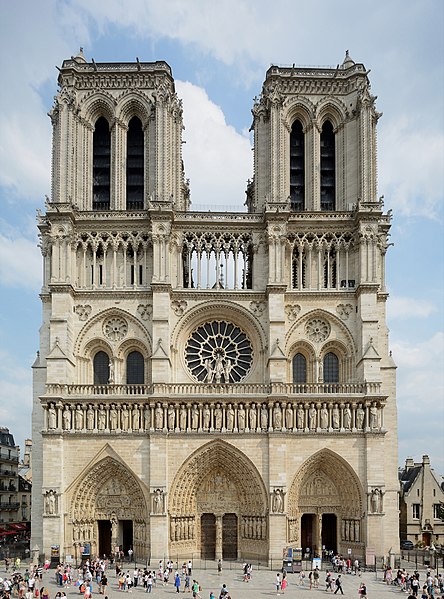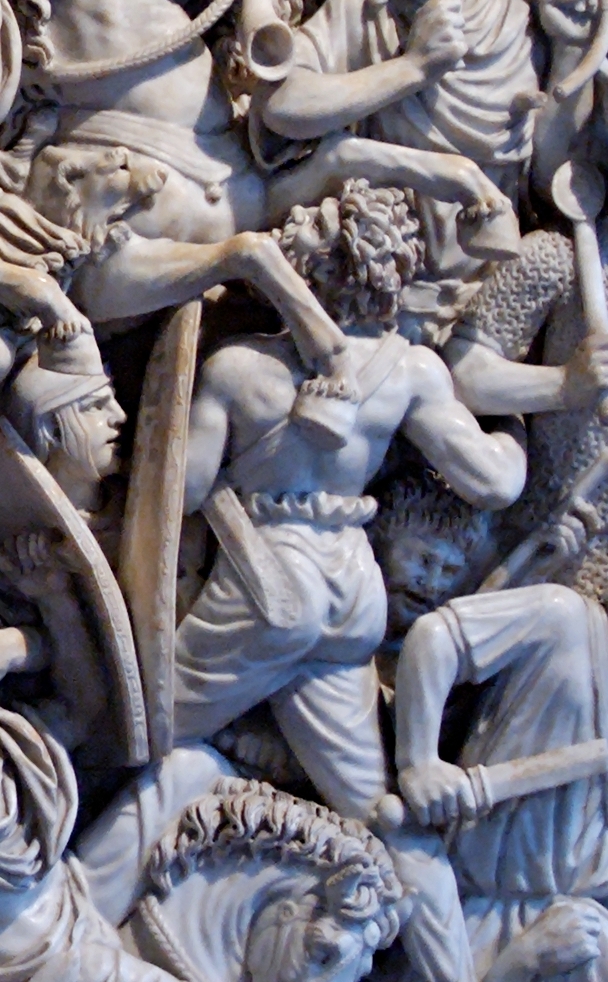Monday, March 23rd, 2020...7:58 pm
An Analysis of the Changing Meanings of “Gothic” and “Goth” Throughout History
[anonymous]
The word “Gothic” has both a complex history and a variety of meanings. Originally related to a variety of ancient Germanic tribes, the word slowly became a synonym for “barbaric” as time went on. During the early modern period, the term then became retroactively applied to architecture popularized in the twelfth and thirteenth centuries, as such architecture was considered “barbaric” by critics. However, through the revival of Gothic architecture in the mid-eighteenth century, as well as through the creation of new “Gothic” forms of media, the term shifted into a more positive connotation, and developed to represent a variety of artistic signifiers, as opposed to any notion of barbarianism.
The etymology of “Gothic” originally traces back to several ancient Germanic tribes who were collectively known as the “Goths.” However, these tribes had individually specific names; for example, two of the most prominent tribes, the later-named Visigoths and Ostrogoths, who were involved in the ransacking of Rome in 410 CE, referred to themselves as the Thervingi and Greuthungi (Fischer 143-144). “Goth,” as a generalized term, arose out of an adaption of a word from the Gothic language. Etymologically, the word “Goth” is related to the Gothic word Gutþiuda, meaning “gut” or “Goth” people (Lehmann 163-164; “Goth, n.”). The “gut” prefix is related to the verb giutan, meaning “to pour”; some scholars therefore theorize that the origin of the term “Goth” had some relation to the “flooded homelands” of the various tribes, or that “gut” could even refer to the sea or bay, thus making the term Gutþiuda roughly equivalent to “sea people” or “flooded-lands people” (Lehmann 163-164). This explanation is only one of many theories, however, and so, although the etymology can be traced, the exact meaning remains an area of debate.
Culturally, the Goths became known as “barbaric” to other peoples due to their actions. The Visigoths and Ostrogoths, for example, were involved in the ransacking of Rome in 410 CE, as well as a variety of smaller attacks beginning in 238 CE, both of which contributed to later generations viewing the Goths negatively (Fischer 143; Wolfram 1-18). Furthermore, their religious practices and rituals, such as the ways in which they buried their dead, went against Roman and Christian traditions, which served to hamper public opinion due to the ever-increasing influence of both the Romans and Christianity (Fischer 143; Wolfram 1-18). Within Rome in particular, a Goth would be categorized as a “barbarus,” the Latin equivalent of “barbarian” (Wood 39-50). For example, the fifth century Salvian, in translation, states that “for in the Gothic country the barbarians [translated from the Latin plural barbari] are so far from tolerating this sort of oppression that not even Romans who live among them have to bear it” (Kristinsson 172; James 5). Essentially, the Goths’ frequent attacks on western targets and their lack of Roman tradition both led to the term “Goth” being associated with the term “barbarian”; the Romans would almost exclusively classify the Goths as barbarians, which would then influence the views of later cultures that held ties to the Roman empire.
In later centuries, the term “Gothic” would slowly outgrow its direct relationship to the Goths through a newfound usage in describing certain forms of architecture. Beginning in the 1500’s with the criticism of Giorgio Vasari, the term “Gothic” started to become retroactively applied to certain styles of architecture that were popularized in the twelfth and thirteenth centuries (Fischer 143-144). Following the previously set relationship of the word “Goth” to the term “barbarian,” critics began to use the term “Gothic” to describe the style, often seen in “the great cathedrals of … France,” as “barbaric” (143-144). This all largely occurred during a period of classical revival, which sought to return to art forms and architecture seen during the era of the Romans and Greeks; in the minds of critics such as Vasari, the continuation of “Gothic” architecture was “reminiscent of the destruction of Roman buildings during the Gothic sacking of Rome,” which meant that the style should be heavily discouraged (Fischer 143-144; Lovejoy 421). Because of this discourse, the term “Gothic” became somewhat disconnected from the Goths themselves, instead becoming a generalized term used to describe subjects antithetical to classical ones.

A picture of the Notre-Dame de Paris, one of the most well-known examples of early Gothic architecture (Haas).
In the mid-eighteenth century, a “Gothic revival” period began, once again changing the significance of the word (Fischer 143-144). Although applied to the same architecture, this time the term took on a positive connotation, as Gothic style architecture became favourable and was encouraged in building (Lovejoy 431-446). From this point onwards, “Gothic” became bound more so to the architecture itself, as opposed to the concept of barbarianism. “Gothic” cathedrals and other buildings were called Gothic not out of an attempt to critique, but simply out of an attempt to categorize the architecture in the same manner that it had been categorized in the past. Thus, to call something “Gothic” meant to describe it as having the features of the now newly revived twelfth and thirteenth century architectural style.

An illustration from a 1794 German edition of The Castle of Otranto, one of the first “Gothic” novels (Houghton Library).
Invoked by the revival of Gothic architecture, many new forms of media relating to the idea of the “Gothic” began to arise, with one of the most prominent examples being Gothic literature (Fischer 143-144). As most would argue, Gothic literature began in 1764 with Horace Walpole’s The Castle of Otranto (Hume 282); later subtitled “A Gothic Story” in its second edition (Walpole x), the novel combined horror and intense emotion into the setting of a Gothic castle, which would later become a trope of many Gothic novels (Hume 282-284). However, later novels, such as Mary Shelley’s Frankenstein, would break away from this setting while placing a larger focus on horror and the unnerving of the reader, thereby establishing the idea of “Gothic,” in regard to fiction and certain forms of media, as being something that provokes, challenges, or frightens (285). This meaning remains today, as certain modern works of more abstract horror are sometimes described as “Gothic.”
Today, the idea of what is “Gothic” proves to be a very open-ended question, as “Gothic” qualities have been expanded upon and applied to a variety of differing subjects, concepts, and media forms. Specifically, as a result of technological developments in the twentieth century, “Gothic” styles have found their way into a variety of new mediums. Today, there exists Gothic architecture, literature, film, music, fashion, and more (Fischer 143-148). Furthermore, subcultures have emerged as a result of these new mediums of expression, with one of the most significant modern-day examples being the Goth subculture formed around the “70’s post-punk music scene” (143-148). Even to this day, the definition of what is “Gothic” continues to evolve and expand; although originating simply as a means of description for select Germanic tribes, the word and its related terms have been able to evolve over hundreds of years so as to a develop a rich, continuously expanding meaning.
Works Cited
Fischer, Rachel K. “The Gothic Aesthetic: From the Ancient Germanic Tribes to the Contemporary Goth Subculture.” Reference & User Services Quarterly, vol. 58, no. 3, 2019, pp. 143-148.
“Goth, n.” OED Online, Oxford University Press, December 2019, www.oed.com/view/Entry/80221. Accessed 8 February 2020.
Haas, Peter. Untitled Image. Wikipedia: The Free Encyclopedia, 13 April 2014, commons.wikimedia.org/wiki/File:Notre-Dame_de_Paris_2013-07-24.jpg. Accessed 7 February 2020.
Houghton Library. “Illustration from a 1794 German Edition.” Wikipedia: The Free Encyclopedia, 23 September 2014, commons.wikimedia.org/wiki/File:Houghton_EC75_W1654_764cℓ_-_Castle_of_Otranto,_ill.jpg. Accessed 7 February 2020.
Hume, Robert D. “Gothic versus Romantic: A Revaluation of the Gothic Novel.” PMLA, vol. 84, 2, 1969, pp. 282–290.
James, Edward. Europe’s Barbarians AD 200-600. Routledge, 2014.
Kristinsson, Axel. Expansions: Competition and Conquest in Europe Since the Bronze Age. ReykjavíkurAkademían, 2010.
Lehmann, Winfred P. A Gothic Etymological Dictionary. Brill, 1986.
Lovejoy, Arthur O. “The First Gothic Revival and the Return to Nature.” Modern Language Notes, vol. 47, no. 7, 1932, pp. 419–446.
Nguyen, Marie-Lan. “Depiction of a Gothic Warrior Battling Roman Cavalry, from the 3rd century Ludovisi Battle Sarcophagus.” Wikipedia: The Free Encyclopedia, 17 September 2019, commons.wikimedia.org/wiki/File:Grande_Ludovisi_Altemps_Inv8574_(cropped).jpg. Accessed 7 February 2020.
Walpole, Horace. The Castle of Otranto: A Gothic Story. Edited by W. S. Lewis, Oxford University Press, 1996.
Wolfram, Herwig. History of the Goths. Translated by Thomas J. Dunlap, University of California Press, 1990.
Wood, Ian. “The Term ‘Barbarus’ in Fifth-, Sixth-, and Seventh-Century Gaul.” Zeitschrift Fur Literaturwissenschaft Und Linguistik (LiLi), vol. 41, no. 164, 2011, pp. 39–50.

Comments are closed.